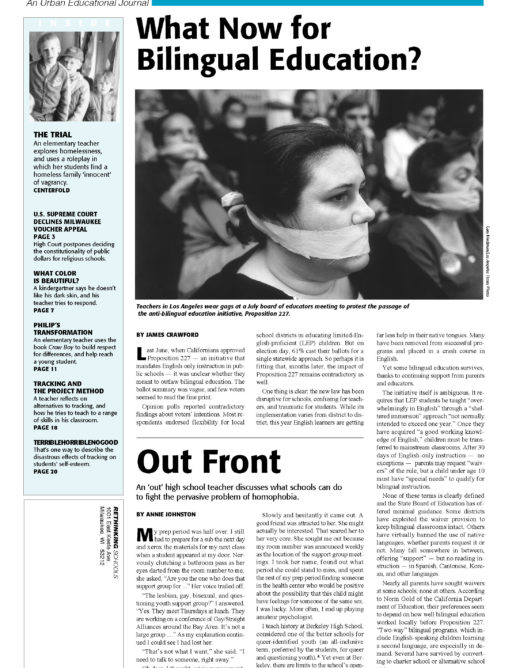Preview of Article:
Out Front
An "out' high school teacher discusses what schools can do to fight the pervasive problem with homophobia.
In this backlash era, out teacher role models are an endangered species. Even in the progressive Bay Area, there have been major flaps over a teacher allowing a brief discussion of the “Ellen” coming-out episode, and a teacher simply letting it be known to her classes that she is lesbian.
At the same time, Gay Straight Alliances are growing at a phenomenal rate. When students in Salt Lake City formed a Gay Straight Alliance in 1995, the district banned all clubs rather than allow the alliance to meet. But protesting students walked out en masse and marched to the state capital, forcing the state legislature to intervene and countermand the district. In addition, there have been significant legal victories in recent years – in particular the case brought by Jamie Nabozny, which held school administrators liable when a gay student was harmed by harassment that the administrators had ignored despite the existence of a district anti-harassment policy. Many districts have also been more open to training staff on how to create a safe environment for lesbian and gay youth.
At my school, the lesbian, gay, bisexual, and questioning youth support group is an important place for students to find each other and establish a supportive community. It is difficult, however, for those students to be activists around gay issues at school. They face constant harassment and ridicule. It is equally difficult for students who are unsure of their sexual identity to take the radical step of coming to such a gay-identified group.
Take the situation facing Jake, who was ridiculed by other students the entire semester two years ago in my World History class. He came midyear, he said, because he had been so ostracized in his last school. He had a manner about him that just spoke of weirdness and difference. By the end of four months, students would write things on the board about him, no one would work with him, and he would take it all in as if he deserved it. After he brought in a crucifix he’d made in shop class and announced to me that the bloody body hanging from it was himself, I redoubled my efforts to get him seen by a counselor, but to no avail. It was May by that time, the university interns who helped out at the health center were gone for the year, and there was really no one who could help.
Jake spent time hospitalized over the summer for severe depression and on suicide-watch, I think. He spent more time hospitalized in the fall. After he left the hospital, he came by to tell me he had known he was gay since he was seven years old. He’d been in denial, hoping and praying that something would change him.

